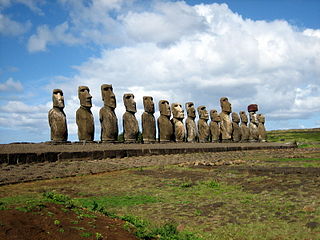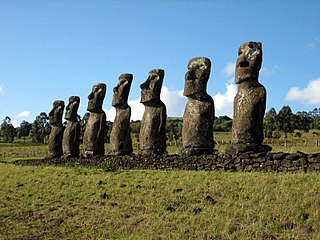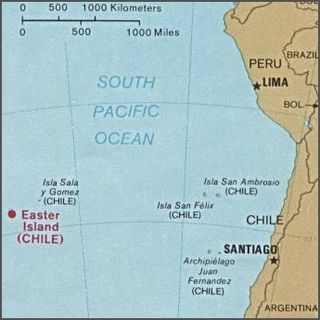
Easter Island is an island and special territory of Chile in the southeastern Pacific Ocean, at the southeasternmost point of the Polynesian Triangle in Oceania. The island is most famous for its nearly 1,000 extant monumental statues, called moai, which were created by the early Rapa Nui people. In 1995, UNESCO named Easter Island a World Heritage Site, with much of the island protected within Rapa Nui National Park.

Hanga Roa is the main town, harbour and seat of Easter Island, a municipality of Chile. It is located in the southern part of the island's west coast, in the lowlands between the extinct volcanoes of Terevaka and Rano Kau.

Moai or moʻai are monolithic human figures carved by the Rapa Nui people on Rapa Nui in eastern Polynesia between the years 1250 and 1500. Nearly half are still at Rano Raraku, the main moai quarry, but hundreds were transported from there and set on stone platforms called ahu around the island's perimeter. Almost all moai have overly large heads, which comprise three-eighths the size of the whole statue. They have no legs. The moai are chiefly the living faces of deified ancestors. The statues still gazed inland across their clan lands when Europeans first visited the island in 1722, but all of them had fallen by the latter part of the 19th century. The moai were toppled in the late 18th and early 19th centuries, possibly as a result of European contact or internecine tribal wars.

The Rapa Nui are the indigenous Polynesian peoples of Easter Island. The easternmost Polynesian culture, the descendants of the original people of Easter Island make up about 60% of the current Easter Island population and have a significant portion of their population residing in mainland Chile. They speak both the traditional Rapa Nui language and the primary language of Chile, Spanish. At the 2017 census there were 7,750 island inhabitants—almost all living in the village of Hanga Roa on the sheltered west coast.

Rano Raraku is a volcanic crater formed of consolidated volcanic ash, or tuff, and located on the lower slopes of Terevaka in the Rapa Nui National Park on Easter Island in Chile. It was a quarry for about 500 years until the early eighteenth century, and supplied the stone from which about 95% of the island's known monolithic sculptures (moai) were carved. Rano Raraku is a visual record of moai design vocabulary and technological innovation, where 887 moai remain. Rano Raraku is in the World Heritage Site of Rapa Nui National Park and gives its name to one of the seven sections of the park.

Motu Nui is the largest of three islets just south of Easter Island and is the westernmost place in Chile. All three islets have seabirds, but Motu Nui was also an essential location for the Tangata manu cult which was the island religion between the moai era and the Christian era. Motu Nui is the summit of a large volcanic mountain which rises over 2,000 meters from the sea bed. It measures 3.9 hectares in land area and is the largest of the five satellite islets of Easter island. It is one of three islands that is closest to Point Nemo, the place in the ocean that is farthest from land, the other two being Ducie Island, one of the Pitcairn Islands, and Maher Island in Antarctica.

Rapa-Nui is a 1994 American historical action-adventure film directed by Kevin Reynolds and coproduced by Kevin Costner, who starred in Reynolds's previous film, Robin Hood: Prince of Thieves (1991). The plot is based on Rapa Nui legends of Easter Island, Chile, in particular the race for the sooty tern's egg in the Birdman Cult.

Rapa Nui National Park is a national park and UNESCO World Heritage Site located on Easter Island, Chile. Rapa Nui is the Polynesian name of Easter Island; its Spanish name is Isla de Pascua. The island is located in the southeastern Pacific Ocean, at the southeastern extremity of the Polynesian Triangle. The island was taken over by Chile in 1888. Its fame and World Heritage status arise from the 887 extant stone statues known by the name "moai", whose creation is attributed to the early Rapa Nui people who inhabited the island starting between 300 and 1200 AD. Much of the island has been declared as Rapa Nui National Park which, on 22 March 1996, UNESCO designated a World Heritage Site under cultural criteria (i), (iii), & (v). Rapa Nui National Park is now under the administrative control of the Ma´u Henua Polynesian Indigenous Community, which is the first autonomous institute on the island. The indigenous Rapa Nui people have regained authority over their ancestral lands and are in charge of the management, preservation and protection of their patrimony. On the first of December 2017, the ex-President Michelle Bachelet returned ancestral lands in the form of the Rapa Nui National Park to the indigenous people. For the first time in history, the revenue generated by the National Park is invested in the island and used to conserve the natural heritage.

Easter Island was traditionally ruled by a monarchy, with a king as its leader.

Rapa Nui mythology, also known as Pascuense mythology or Easter Island mythology, refers to the native myths, legends, and beliefs of the Rapa Nui people of Easter Island in the south eastern Pacific Ocean.

Hoa Hakananai'a is a moai, a statue from Easter Island. It was taken from Orongo, Easter Island in 1868 by the crew of a British ship and is now in the British Museum in London.

Ahu Tongariki is the largest ahu on Easter Island. Its moais were toppled during the island's civil wars, and in the twentieth century the ahu was swept inland by a tsunami. It has since been restored and has fifteen moai, including one that weighs eighty-six tonnes, the heaviest ever erected on the island. Ahu Tongariki is one kilometer from Rano Raraku and Poike in the Hotu-iti area of Rapa Nui National Park. All the moai here face sunset during the winter solstice.

Ahu Akivi is a particular sacred place on the Chilean island of Rapa Nui, looking out towards the Pacific Ocean. The site has seven moai, all of equal shape and size, and is also known as a celestial observatory that was set up around the 16th century. The site is located inland, rather than along the coast. Moai statues were considered by the early people of Rapa Nui as their ancestors or Tupuna that were believed to be the reincarnation of important kings or leaders of their clans. The Moais were erected to protect and bring prosperity to their clan and village.

Maunga Puna Pau is a small crater or cinder cone and prehistoric quarry on the outskirts of Hanga Roa in the south west of Easter Island. Puna Pau gives its name to one of the seven regions of the Rapa Nui National Park.
Since the removal from Easter Island in 1868 of the moai now displayed at the British Museum, a total of 12 moai are known to have been removed from Easter Island and to remain overseas. Some of the moai have been further transferred between museums and private collections, for reasons such as the moai's preservation, academic research and for public education. In 2006, one relocated moai was repatriated from the Centro Cultural Recoleta in Argentina after 80 years overseas. In 2022, one moai held in the Chilean National Museum of Natural History in Santiago was returned to the island after 150 years abroad.

Geologically one of the youngest inhabited territories on Earth, Easter Island, located in the mid-Pacific Ocean, was, for most of its history, one of the most isolated. Its inhabitants, the Rapa Nui, have endured famines, epidemics of disease, civil war, environmental collapse, slave raids, various colonial contacts, and have seen their population crash on more than one occasion. The ensuing cultural legacy has brought the island notoriety out of proportion to the number of its inhabitants.

The Father Sebastian Englert Anthropological Museum is a museum in the town of Hanga Roa on Rapa Nui in Chilean Polynesia. Named for the Bavarian missionary, Fr. Sebastian Englert, OFM Cap., the museum was founded in 1973 and is dedicated to the conservation of the Rapa Nui cultural patrimony.
Hotel Hanga Roa, also known as Hanga Roa Eco Village & Spa, as of 2020 branded as Nayara Hangaroa, is a hotel in Hanga Roa, Easter Island, overlooking the bay on the Avenue Pont. The hotel was used extensively in the 1994 film Rapa Nui. In 1994, the hotel was purchased by the Panamericana hotel firm who extended the property with 10 fake thatched roofed bungalows, nine of which have three rooms. The 60 other rooms are located in the main building. Later, the hotel was acquired by Tanica hotels, owned by the Schliess family from mainland Chile. The Hito family, an extended family from Easter Island, occupied the premises for six months in 2010, claiming ancestral property rights. The hotel closed in 2011 for refurbishment and was projected to include a new museum and theatre, shopping complex, pool, tennis courts and other rooms. The hotel staff were mainly Rapa Nui locals, but the management was not from Easter Island. After a protracted conflict between the Hito family and the Schliess family, an agreement was reached in 2020. Under the agreement, property rights were transferred to the Hito family while the Tanica hotel group retained the right to exploit the hotel for 15 years. In 2020 the Costa Rican Nayara Resort group took control of the marketing.
Gonzalo Figueroa Garcia Huidobro, often referred to simply as Gonzalo Figueroa, was an archaeologist and authority on the conservation of the archaeological heritage of Rapa Nui. Figueroa's work included participating in Thor Heyerdahl's Rapa Nui expedition, restoring Ahu Akivimoai with William Mulloy, and working generally for over four decades to conserve and, in some cases, restore the archaeological monuments of Rapa Nui for future generations.

The COVID-19 pandemic was confirmed to have reached the Chilean island and special territory of Easter Island in March 2020.
















